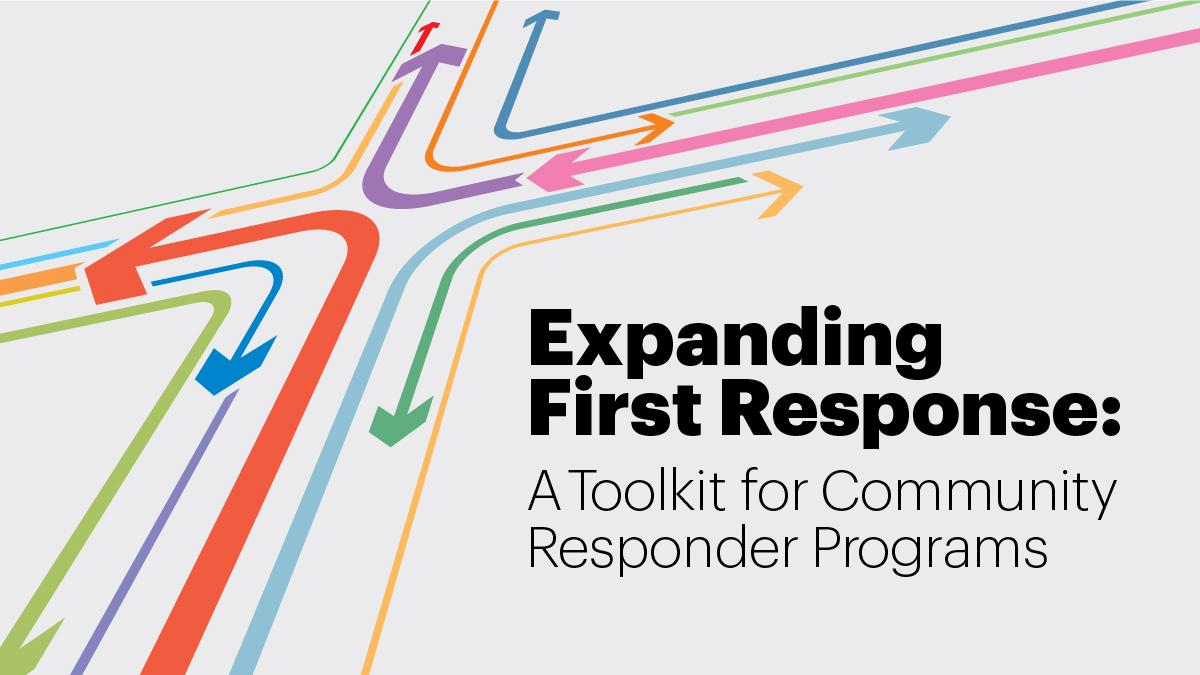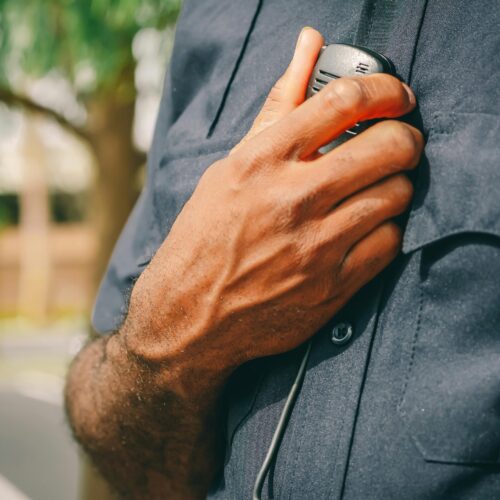
Funding Community Responder Programs: A Q&A with the CAHOOTS Program in Oregon
Community responder programs are increasing nationwide as effective models for providing immediate assistance to people in crisis, facilitating connections to support services, conducting wellness checks, and more. These programs position health professionals and trained crisis staff as first responders to behavioral health crises and social disturbances.
To support these efforts, The Council of State Governments (CSG) Justice Center and Vital Strategies launched a groundbreaking toolkit, Expanding First Response: A Toolkit for Community Responder Programs, and connected with several programs across the country to learn from their successes and their challenges. One program that was instrumental to the development of the toolkit is Crisis Assistance Helping Out On The Streets (CAHOOTS), which has been operating out of Eugene, Oregon for more than 30 years.
Last year, as part of the toolkit’s initial launch, the CSG Justice Center spoke with then-CAHOOTS Director of Consulting Timothy Black, Coordinator Ebony Caprice Morgan, and Consulting Associate Abbey Carlstrom about the program’s experience conducting needs assessments. Since then, Mr. Black agreed to speak to the CSG Justice Center for a series of interviews: the first covered ways that programs can manage partnerships with other first responders. In this interview, he outlines CAHOOTS funding efforts, challenges, and successes.
Editor’s note: This interview has been edited for length and clarity.
The CAHOOTS model has been around for more than 30 years and is now replicated nationwide. How was it initially funded and what has kept it going this long?
When the CAHOOTS program started, it was just City of Eugene funding. And in fact, when I got hired in 2010, there was a lot of uncertainty around how safe our budget was and if we were going to be on the chopping block every November. In the last 10 to 11 years, we’ve started to build a relationship with our county health and human services provider, and more recently, we have seen tremendous increases in our opportunities for funding from foundations, philanthropic partners, and Medicaid providers in Lane County.
Our bedrock funding is still with the city of Eugene, and that has remained consistent since its inception. However, with the addition of Medicaid funding, this is the first time that we’re seeing direct recognition of our cost savings in the community really come back to us in dollars and cents.
Even with funding diversity, however, we have had to manage conversations over the years to ensure the sustainability of the program. We approach those negotiations by talking with leadership about what we’re doing and how it’s benefitting them. It’s a lot of relationship maintenance.
You mentioned Medicaid funding. CAHOOTS has the benefit of partnering with White Bird Clinic—a Federally-Qualified Health Center—for mental health and crisis services, which makes it eligible for Medicaid. If a community responder program is not affiliated with a health care organization, however, what other funding opportunities can they pursue?
Other funding can come from public safety tax levies or private foundations. In the case of the STAR program in Denver, it was a grant from Denver Cares that allowed them to fund a site visit to Eugene and also get their pilot program running. There are also several nationwide groups that are supporting community-driven practices in cities that don’t have a connection to a larger health clinic. Additionally, we’re hopeful that the CAHOOTS Act will pass in Congress, which will give state Medicaid programs the ability to fund some mobile crisis services outside of a facility setting.
What are some of the upfront costs that new programs may not be aware of?
The sheer amount of equipment that you need to operate is astonishing. You need inventory to resupply in the first month or two of your operation, and the van is way more expensive than just buying a new cargo van off the lot. It was $40,000 for us just to get the vehicle and another $30,000 to $40,000 to customize.
Having a fund for things like a tank of gas for somebody or hotel rooms for a night, those are things that go a long way in making a difference for somebody that aren’t always considered as part of crisis response. One other upfront cost would be that if you’re not going to be doing this work with the support of a public safety system for dispatch, there are other software resources out there, but those have a price tag.
Once programs are past the start-up phase, are there other costs that they should include in a long-term budget?
Having adequate funding for overtime and relief coverage is really important. Oftentimes, there’s not funding to pay overtime when you call in sick and someone else has to cover that shift. CAHOOTS didn’t initially pay close enough attention to what it costs to provide long-term coverage and support staff when they need to take time off.
What type of planning do you recommend for new programs to set themselves up for continued funding?
Create a really solid communications strategy if you’re pursing private grants. Effective data collection also helps donors understand your program’s progress, especially when you can include this in annual reports made available to the public. Additionally, you need a really solid business plan. If you have that business plan, it becomes easier to identify and develop a roadmap for the vision of your program.
Expansion can also be challenging. Usually, expanding services means bringing in a lot more staff and having to purchase more supplies. For example, if we’re going to expand services by 12 hours, then I know that I need a 20 percent increase in the medical supply donation, and we’re going to expect to see a 20 percent increase in our expenses for fuel. If you’re going to be doing something really different or big, like expanding into a new community, then you will need to make sure you’re dedicating a lot of resources to education and outreach, and that you’re accounting for ride-alongs with public safety personnel to train new staff.
What are some things you wish you had known about building sustainable community responder programs early on?
If we were to get this program started today, I think we would ask for almost twice as much money. We don’t currently have an employer match for a retirement plan, and we can’t insure family members and dependents. We should be able to offer a life insurance policy and better pay for our staff. Those are things beyond our ability to provide right now because our funding is so limited.
Having adequate funding resources to empower a community advisory board is also something important and necessary that I wish we’d pushed for in the beginning. It would have been so valuable to have the contributions of community members, but that has a financial cost: you need to provide childcare so people can come to hearing sessions and you need to have a stipend if you’re asking somebody to contribute their knowledge and expertise from their lived experience to your program.
How is CAHOOTS supporting the sustainability of the program with all these learned lessons in mind?
At the local level, we leverage a lot of relationships that the city government has, and we keep our partners informed through joint messaging opportunities. That even extends to our housing authority and groups that are working with rental assistance and landlord-tenant rights to make sure that they know how to access us as part of a prevention network.
On a state level, we’ve been involved in planning sessions and have attended hearings with our state legislature around funding for crisis services and mobile crisis teams. A lot of that work and advocacy resulted in the passage of House Bill 2417, which declared a state of emergency for mental health in Oregon and created funding for mobile crisis services, as well as mental health services, shelter, basic needs, and sobering and detox facilities. We saw opportunities through the passage of that legislation to advocate for a larger network of resources that will allow crisis teams to do their best work and have maximum input.
About the authors


This May, the state of Washington passed legislation supporting the expansion of alternative response teams (sometimes called community…
Read MoreThe CSG Justice Center has partnered with the Pennsylvania Commission on Crime and Delinquency and CIT International to…
Read More Developing a Common Definition for Community Responder Programs
Developing a Common Definition for Community Responder Programs
This May, the state of Washington passed legislation supporting the expansion of alternative response teams (sometimes called community responders) as a public safety service.
Read More CSG Justice Center Launches Nation’s 1st Statewide Crisis Intervention Teams (CIT) Technical Assistance Center in Pennsylvania
CSG Justice Center Launches Nation’s 1st Statewide Crisis Intervention Teams (CIT) Technical Assistance Center in Pennsylvania
The CSG Justice Center has partnered with the Pennsylvania Commission on Crime and Delinquency and CIT International to launch the first statewide Technical Assistance (TA) Center in the country.
Read More









